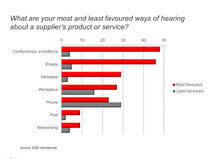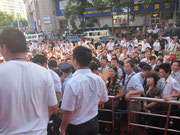
Trade fairs and exhibitions are a vital sales and marketing tool in China.
According to a recent B2B International study, industrial buyers rated trade shows as the most favoured communication channel with potential suppliers (figure 1). Strategically selected trade shows ensure buyers get to know your company products and services, enable face-to-face communication and facilitate closing deals.
But, just like anywhere else, exhibiting at a trade fair in China is time consuming and cost intensive. So, to help save you time and money I would like to share some very practical tips that will help you ensure the success of your trade show participation in China.
1. Clearly defined and communicated goals

...are the foundation of a successful exhibition. Which of these do you want to achieve through the show?
- Enhancing brand awareness/image
- Refreshing contacts with existing customers
- Generating new sales leads
- Establishing contacts with business partners, suppliers, distributors
- Conducting market research and observation
- Closing direct sales
Usually you have more than one goal; try to prioritise them and develop your plan accordingly.
2. Choosing the right exhibitions
...among the thousands of trade fairs in China is a challenge. Before making a decision, check the following information:
-
Background of the organiser – history, track record, reputation,
professionalism - Location of the fair – Is it near your target markets? Or would your target groups travel a long distance (in China it could mean thousands of kilometres) to visit the exhibition?
- Nature of the exhibition – horizontal (including a broad spectrum of segments) or vertical (specialised in a segment, e.g. wind energy).
- List of (past) exhibitors – Are/were your competitors/business partners there? Ask them for their experience. Do you want to be present among these companies?
- Number of visitors and profile – Are they your potential customers/partners? Decision makers?
- Mix of domestic and international exhibitors and visitors
Whenever possible, visit the shortlisted exhibitions yourself to get the real picture before participating as an exhibitor. Another way to reduce risks is to join a group exhibition of your country’s or region’s economic organisations (e.g. Chambers of Commerce). On the AUMA website (www.auma.de), there is an extensive list of exhibitions worldwide.
3. Allowing sufficient time for planning and organisation
...enhances your chances of success, especially if you are exhibiting in China for the
first time. Geographical distances, cultural differences, communications barriers…etc. could make things work slower than what you are used to at home.
4. Selecting the right exhibition contractor

...is essential to a successful show. Some exhibitors work with European contractors to build their booths in China. This is certainly a safe way to assure quality, but it can be expensive. Domestic booth contractors cost much less than their European counterparts. Really good ones have excellent local knowledge such as visitors’ behaviour and conditions of the exhibition location. However, strict quality control and close monitoring are required – from concept, budget, detailed construction drawings, to the actual building. If you don’t have local employees to check the booth construction on site, you should arrive at least 24 hours before the exhibition begin to ensure everything is alright, and if not, there is still time for last-minute remedies.
5. Boost the impact of a show with the right communication prior to the show.
Here are a few tools:
- Trade fair catalogue published by the organiser
- Advertisements with trade fair information
- Press releases with trade fair highlights
- Announcements on own website, social media, newsletters
- Invitations to customers and partners by email or post, whenever possible, with coupons for the entry tickets
- Most importantly, personal invitations by your sales persons during their customer visits
6. An experienced logistics partner
...ensures the smooth processing of shipment, customs clearance, deliveries to booth and, if necessary, return shipment of exhibits and other materials. Arrange your shipment as early as possible to provide a buffer for any complications at Chinese customs.
7. Marketing materials in Chinese language
...are a must if you want your visitors to understand your products and services. Even though English is becoming more popular as a business language in China,
most of your potential customers will struggle to understand more complex and technical contents. All staff, including Europeans, should have sufficient bilingual (English/Chinese) business
cards. Remember to include the country codes of the telephone numbers.
8. Staffing the booth with at least one or two European colleagues
...will strengthen your company’s imported image, which is usually positive in China. Besides, this is also a face-giving gesture to show the importance of the exhibition and visitors. Ensure the Europeans are well informed about the market and trained on cross cultural skills. Even though the Chinese have respect for Europeans, they are usually too shy or lack the language skills to conduct deeper business discussions. Therefore, your Chinese staff should be the major conversation partners. If required, hire a professional interpreter with both language skills and technical knowledge.
9. Other small things that make a difference:
- Prepare small gifts from your home country for special guests and customers. They don’t have to be expensive but should show your attentiveness.
- Whenever possible, get a water cooker at the booth for serving tea to Chinese visitors.
- Invite selected customers to dinner. This deepens your relationship and enhances mutual trust.
10. The real work begins after the show
This applies in China too. Timely follow ups are required to finally score the goals: sending requested information, quotation, visits, further negotiations, feedbacks, etc.
Trade fairs are a major element of any company’s marketing mix. Especially for an exhibition in a remote country like China, you should appoint a dedicated project leader to actively drive the processes forward and keep everything under control.
About the author:
Janet Mo is the co-founder and CEO of Zentron Consulting (www.zentron-consulting.com), specialised in B2B marketing in China. Janet has 22 years marketing experience in China and Europe, including 12 years at renowned advertising agencies such as Ogilvy and Sandberg Trygg, as well as ten years at the Austrian bearing manufacturer NKE as global Head of Marketing. Janet is fluent in Chinese (Mandarin, Cantonese), English and German.

Write a comment